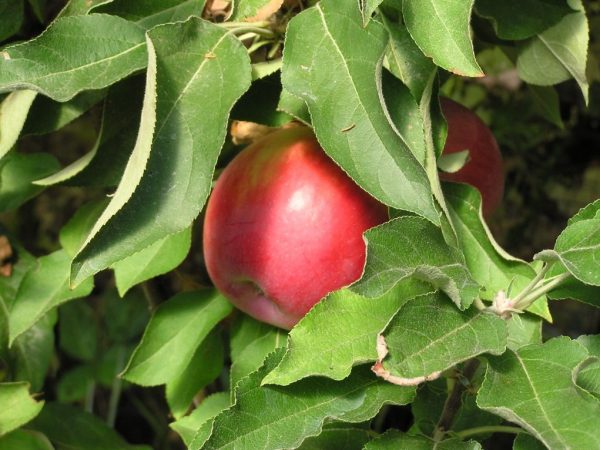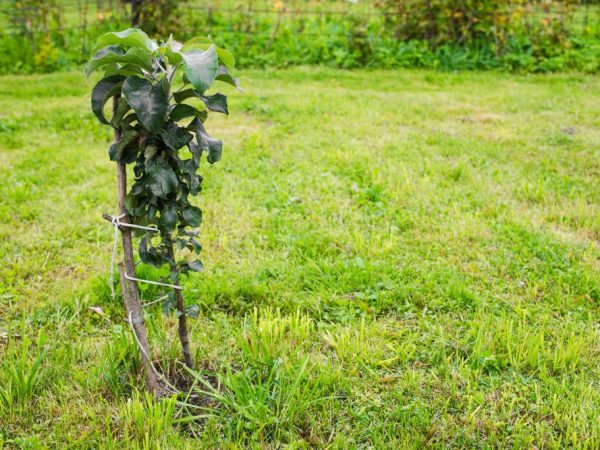Columnar apple variety Gin
Columnar apple tree Gin is an early maturing species. It is popular on small plots of land because it does not require a lot of space.

Columnar apple variety Gin
Characteristics of the variety
Apple tree Gin is fast-growing: the first fruits appear already in the second year. The amount of the crop is increasing every year: already on the 4th you can harvest up to 6 kg. The average figure for a mature apple tree is 15 kg.
In the first years, the culture grows upward and only in the 5th year does it begin to grow in lateral lashes. Because of this structure, apples are formed only on the ringlets.
The fruits ripen at the end of September and hang on the tree until it gets cold. If the crop is harvested on time, the shelf life is increased to six months.
Description of the tree
The columnar apple tree does not grow above 2 m, it thrives on dense planting, therefore it is suitable for growing on small land plots. It gets along easily with other varieties.
A compact crown is formed in the early years: pruning is carried out every year. The branches do not grow on the sides, they are tightly pressed against the trunk.
The tree is grown throughout Russia, even in the Urals.
To a greater extent, the variety is self-fertile. He does not need the neighborhood of other apple trees. But cross-pollination improves fruit quality and size.
Can be used as insect pollinators.
Description of fruits
The mass of one is 120-200 g, the skin is bright red, inside the pulp is juicy and moderately dense, the fine grain is not expressed.
The tasting score is high - up to 4.7 points.
The apples are not only tasty, but also very juicy. For this reason, they have a universal purpose. Juices, compotes and jams are prepared from ripe pulp.
The fruit has a good composition: the pulp contains vitamins that are beneficial for the human body.
Winter hardiness of culture

The variety is frost resistant
Gin belongs to winter varieties. It is winter-hardy and can withstand sudden changes in ambient temperature, it also copes well with temperature instability in autumn and spring.
To increase durability, special winter shelters are used. They help keep the rhizome of the culture from freezing.
It is imperative to protect the seedlings that were planted in the fall. A small tree has enough natural shelter, so when snow falls, it does not need to be cleared.
Advantages and disadvantages
The variety is versatile. With minimal maintenance costs, gardeners benefit greatly - apples are stored for a long time, do not deteriorate and are successfully transported over long distances.
Description of Jin's positive characteristics:
- a culture is grown in central Russia;
- withstands sharp cold snaps, and only the upper part of the rhizome freezes, which quickly recovers in spring;
- good resistance of the variety to powdery mildew.
Scab resistance allows for a stable annual yield.
Even during epidemics, culture does not suffer. It is rarely attacked by pests - in this case, you will need to install special nets. And she also does not suffer from powdery mildew, therefore, with proper care, the fruits do not deform.
The only disadvantage can be attributed to the poor survival rate of the culture on frequently blown land plots.
Landing rules
Gin is grown outdoors. The composition of the soil is not essential: planting is carried out in a pre-fertilized pit.
How to prepare for planting work:
- They buy a two-year-old seedling (one-year-old will not have time to take root). The rhizome should be flexible and not torn off at the slightest pressure. They make sure that there are no spots or plaque on the plant. There should be no leaves either, only a few processes.
- A planting pit is created with a depth of 70 cm and a diameter of no more than 80 cm. For fertilization, compost or slurry is used (applied to a layer of 5-6 cm). The pit is left with replenishment for a week, and then it is mixed with the topsoil and defended for another week. After that, a peg is driven in to make additional support.
For soils with a groundwater height of 3-4 m, additional drainage is created: a layer of rubble is laid there and only then a seedling is planted.
Timing
Apple trees are planted 2 times a year: in spring or autumn.
The spring procedure takes place in mid-May. It is important that the first buds do not have time to form on neighboring apple trees. During spring planting, the temperature of the soil layer is measured. If you plant the material before the soil warms up, the rhizome may die.

Planting can be done in spring and autumn.
Autumn planting involves the preparation of winter flooring so that the young tree does not die from imminent frosts.
The pit must be prepared a month before the expected cold snap. By this time, the entire crop is harvested.
If it was not possible to plant before the end of September, the seedling will no longer have time to adapt. In this case, the planting material is stored in a cool room until spring.
Landing technology
For the rapid growth of the apple tree, a distance of at least 1 m is maintained between the rows.
It is better not to choose a land plot in the lowland, because stagnant water will flow to the rhizome.
You cannot choose a place in the shade or under cover, it must be sunny.
Columnar apple trees are planted with support. For this, a metal stake is placed in the planting pit.
When placing the rhizomes in the hole, all the roots are carefully leveled and covered with soil. From above they are rammed with fresh soil. A roller is created around the trunk. It will improve the quality of irrigation in the future.
During planting, the seedling is watered abundantly (use at least 5 buckets of warm water).
Mulching is used during autumn planting. At the trunk, a flooring is created, which will allow the rhizome not to react to sudden changes in external temperature.
For the winter, the tree is not watered or fertilized: as soon as frosts begin, any moisture in the soil is dangerous.
Care features
Watering
In total, 2-3 feedings are carried out per season. Ample watering is preferable to the amount of moisture.
But it is also impossible to overly moisturize the rhizome, so as not to get the opposite effect.
The root system quickly adapts and begins to independently regulate the water level. Irrigation works are carried out by a water charging system.
The younger the tree, the farther from the trunk you need to water. For convenience, a shallow trench is created around the seedling, into which water (settled) is introduced.
You cannot take dirty water or river liquid - they contain an increased amount of pathogenic microorganisms.
In order for the water to warm up before watering, it is better to leave it in the sun in the morning. Top dressing and feeding are well combined.
Fertilizing the soil
Top dressing is important during the growing season.While the apple tree is growing, fertilizer is applied 3-4 times per season (using organic matter and mineral fertilizers).
Compost, humus or chicken droppings are selected as organic matter. They are diluted with water to reduce the concentration of active substances.
Mineral fertilizers should contain large amounts of potassium, phosphorus and nitrogen. Purchased supplements help during the period of active growth. Between dressings, the apple tree "rests" for a month.
Prophylaxis

The apple tree needs good care
All weeds are necessarily removed from the site. Even small plants can draw out the moisture needed by the rhizome.
Before watering or fertilizing, the soil is loosened - this procedure improves the throughput of the soil.
For preventive treatment or spraying of apple trees, fungicides are used that protect against powdery mildew or scab.
Pruning branches
An obligatory procedure for maintaining the health of the tree is pruning. It is held only twice a year.
- In the spring. The name of such a trim is formative. It is carried out at will - to give the crown a certain shape and remove crooked or broken branches .. This must be done before the ovaries appear, then the tree will have time to recover and bloom correctly.
- In the autumn. Mandatory sanitary pruning. It is carried out in the autumn, after the harvest. The procedure helps to protect the crop, make it less vulnerable to attack by pests, and also prevents diseases in the spring. Broken and dry twigs are cut off. If there are spots or damage on the shoots, they are removed, and the cut sites are disinfected. During pruning, you need to inspect all the branches so that the larvae of parasites do not hide on them. After the procedure, the tree is covered with nets from pests, and the soil is mulched.
Pruning is necessary every year - with it regular watering and fertilization of the soil resumes or preparation for the winter period begins.
Fruit ripening
According to the description, the Gin variety is considered early: under favorable conditions, a couple of fruits are formed on the apple tree after a year, but they are not too large or juicy.
In the 3rd year, the crop can be harvested and used for its intended purpose. And from the fifth year, the tree gives a constant amount of fruit.
With proper care, the tree blooms from May to June.
Early spring allows harvesting by early fall. But if the spring period turned out to be cold, then the apples will ripen only by the end of September.
A strong gusty wind can lead to a decrease in yield, which breaks young branches, so the tree needs shelter.
Harvesting and storage
Immediately after harvest, the crop can be left for the winter or used to prepare healthy meals.
They pick apples at the same time, because they all ripen the same way. They are distinguished by good keeping quality (they are stored for six months) and are easily transported - they are grown for sale.
Even long-term storage of the crop does not affect the appearance of apples or their quality characteristics.
Store in a cold place. It should not be allowed to have high humidity, otherwise the apples can rot. It is best not to put the fruit together with other varieties.
Damaged or diseased apples are thrown away immediately.
Gardeners reviews
The Gin apple tree is rated by gardeners as a promising and profitable variety. Already six months after planting, the first ovaries are formed on the branches, and by autumn full-fledged fruits appear.
The apple tree is distinguished by its high winter hardiness, it is the best option for central Russia, moreover, it will become a real decoration of the land plot and a useful crop for the gardener.

